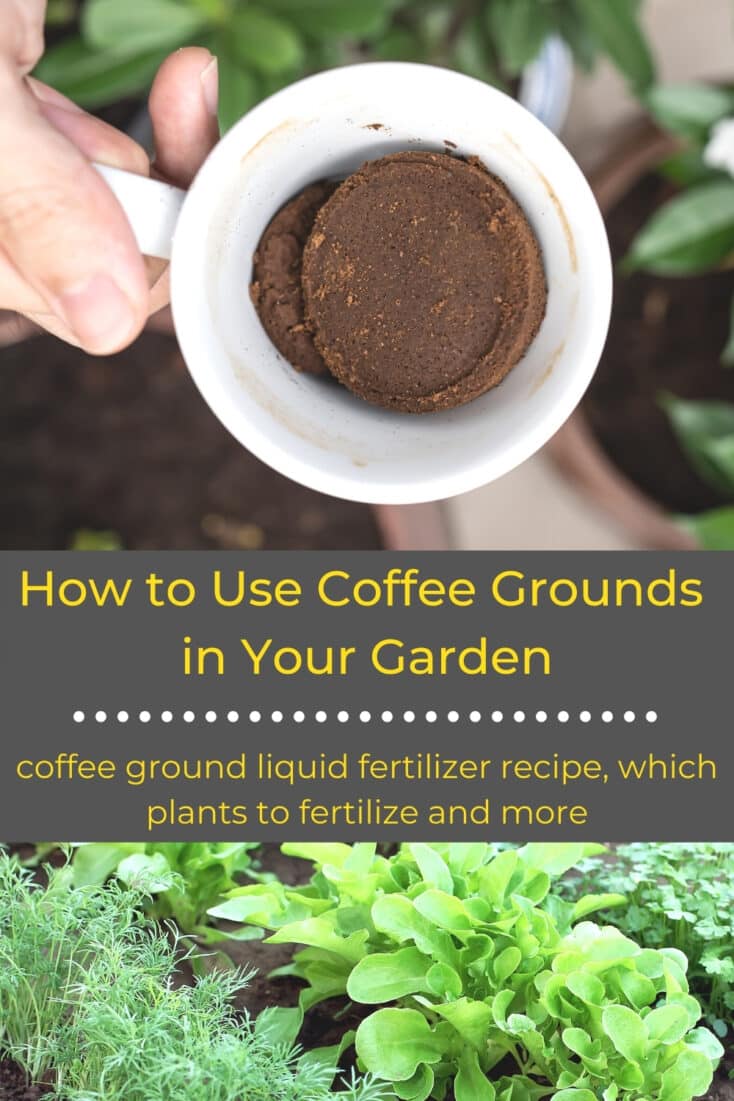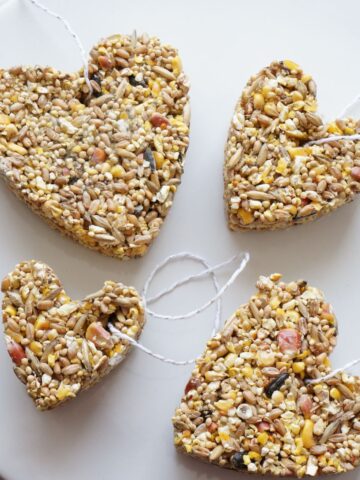Let's get back to tips for building an awesome home garden. The other day the girls and I were standing in line at Starbucks when we noticed a bin filled with silver bags and a sign offering these bags of used coffee grounds...for free. Always in search of a "good deal" we grabbed a bag and brought it back to our garden. Have you ever wondered how to use coffee grounds in the garden? We've got all the tips and tricks!

Disclosure: There are Amazon Affiliate links in this article which means, at no additional cost to you, we could receive compensation for our recommendations. You can read our full disclosure policy on our Disclosure Page for more details.
Table of contents
How to Use Coffee Grounds in the Garden
I grew up with a mom who loved to garden and who loved coffee. Every once in a while I would see my mom pouring coffee grounds into the garden. I really should have asked her about that...but I didn't. So, now as a "gardener in the making", I decided to do a little research into this coffee ground phenomenon. It turns out that used coffee grounds are actually very helpful in the garden.
Why use coffee grounds in the garden? Are coffee grounds good for plants?

Nitrogen Rich Fertilizer: Plants use nitrogen to produce a protein they need to grow. Plants absorb nitrogen in the soil, through their roots. Most store-bought garden fertilizers are nitrogen-rich. It turns out that used coffee grounds have a helpful level of nitrogen as well, approximately 2%. So, how can we put this to good use? It is beneficial to add used coffee grounds to a compost pile. If you don't have a backyard compost pile, then we are sharing some simple ways to use the grounds in your garden.

Coffee Grounds as a Natural Pest Repellant: First up, coffee grounds are a natural pest repellant. Who knew?! Add coffee grounds to the garden edge and keep ants, snails and slugs out of the garden. Apparently, slugs, snails and ants are not fond of coffee. We piled a ring of coffee grounds around our slug-susceptible hostas. As an added bonus, cats don't like coffee either. It keeps the garden free from becoming a kitty litter for feral cats.
How to Make Coffee Ground Fertilizer for Plants

Who's to say you can't steep old coffee grounds? It's super simple to make coffee ground liquid fertilizer. Here's our coffee ground fertilizer recipe. Place 2 cups of used coffee grounds into a bucket of water (5 gallons) and let it steep overnight. Fill a spray bottle with the coffee mixture and spray it onto garden plants. Using a spray bottle helps make sure that you don't overdose the plants in your garden.

Alternatively, you can skip the steeping and add the coffee grounds directly to your soil. Add a few scoops of used coffee grounds to a small bowl and add water to dampen them. Add the grounds directly around the base of your tomato plants, basil plants or whichever plants you want to fertilize.


Use a kitchen fork to work the coffee grounds into the top layer of the soil. When you water the garden the coffee will seep into the soil and work its magic. This is the easiest way to directly feed your plants. This method also helps you to feed the specific plants you want to feed.
What plants like coffee grounds?
Used coffee grounds are rich in nitrogen which is good. However, they also add acid to the soil, so you have to be a little careful. Not all plants love acidic soil. The best advice is to not overdose the garden with coffee grounds. You may like 3 cups a day, but your plants won't love that much coffee. Even the plants in this list won't love super acidic soil. Typically, I feed my garden with coffee grounds 2 or 3 times a season. Once every 3 weeks. If your soil is sandy and lacking acidity, add more. When in doubt, you can pick up a soil testing kit at your local garden centre to see how acidic or basic your soil is.
So, which plants like coffee grounds?
- blueberries (LOVE acidic soil)
- azaleas
- rhododendrons
- cucumbers
- tomatoes
- beans
- broccoli
- squash
- onions
- raspberries
- strawberries
My best advice is to try it out with your plants. Start slow and see how your plants respond. I've had great results in my vegetable garden. I find my tomato plants respond very well to the coffee grounds.
Are coffee grounds safe for basil and other herbs?
Yes, coffee ground fertilizer is safe for basil and other herbs. Again, just use it sparingly. Herbs definitely benefit from the nitrogen boost that coffee grounds provide.
Should I use fresh coffee grounds or used coffee grounds?
Please, only add used coffee grounds to your garden. Fresh coffee grounds are far too acidic for the garden. When the coffee grounds go through the brewing process they lose a lot of their acidity. I've only ever used regular, not decaf or flavoured coffee grounds. Decaf wouldn't make a difference, but flavoured coffees might not be great for your garden. The additives in the coffee could compromise the effectiveness or add elements you don't want in your garden. It's best to stick to unflavored coffee grounds.
Where to get coffee grounds to use in my garden?

When we had used all of our Starbucks coffee grounds I knew we needed to start collecting our own coffee grounds. So, we decided to start collecting our coffee grounds at home. We collect ours in a glass measuring cup that I keep beside the sink. This way I can see exactly how much we have. Typically we add our coffee grounds to our compost bin, which our city collects. If you have a home compost be sure to add your grounds to your compost bin.
Have you ever used coffee grounds in your garden? What results did you see?
More Gardening Tips
Looking for more home gardening tips and tricks? Check out our mega-post filled with all kinds of home gardening inspiration
Make sure you are following along...
FOLLOW KITCHEN COUNTER CHRONICLES ON
SUBSCRIBE TO KITCHEN COUNTER CHRONICLES TO HAVE OUR DELICIOUS RECIPES, FUN CRAFTS & ACTIVITIES DELIVERED DIRECTLY TO YOUR INBOX.







Jen says
Hi Sheridan, I typically use a tablespoon or two for each plant. Use a spoon to work the ground into the soil around the base of the plant. Hope this helps. Thanks for stopping by.